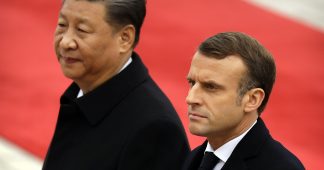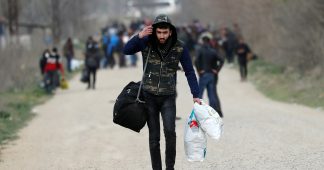Without immediate, genuine transfers of wealth from Global North to Global South to enable just transitions around the world, we stand no chance of meeting our collective goals for limiting the worst impacts of the climate crisis.
By Brandon Wu *
Rich countries have put the world on the brink of climate catastrophe. They have gotten away with decades of inaction on reducing emissions, and on providing finance for the world’s poorer countries to do the same and to support their frontline communities in coping with increasingly severe climate impacts.
Rather than owning up to this decades-long failure and reversing course, rich countries are now only pretending to address the problem by announcing a “Delivery Plan” to meet a longstanding climate finance commitment that they have already failed to deliver on time.
Back in 2009, rich countries agreed to mobilize $100 billion per year in climate finance by 2020. There are two things to know about the much-ballyhooed $100 billion goal. First, it was a politically manufactured number that falls far short of any meaningful estimate of actual need. And second, rich countries failed to meet even this self-assigned, inadequate goal—by a wide margin.
$100 billion is nowhere near enough
One hundred billion dollars sounds like a lot of money. But when the problem we are seeking to address is transforming the economies of, and supporting community adaptation in, 100+ countries, that $100 billion doesn’t actually go all that far.
A recent UN report shows that just the portions of developing country climate action plans (Nationally Determined Contributions, or NDCs, on the Paris Agreement parlance) that are economically quantified will require $6 trillion by 2030, or $667 billion annually. Even this is a massive underestimate, as it only represents about 40% of the actions outlined in the NDCs, with the remainder not yet explicitly costed.
For meeting adaptation needs in developing countries alone, the UN Environment Programme’s most recent Adaptation Gap report estimates that $140-300 billion annually will be needed by 2030. There is a relative lack of rigorous studies on financing needs to address permanent loss & damage, but one recent study arrives at an estimate of $290-580 billion annually by 2030 (for a more accessible distillation of the issues surrounding loss & damage finance, see this Heinrich Boell briefing paper).
The Paris Agreement extended the $100 billion goal to 2025, with a process to determine a new collective finance goal for the post-2025 period. With the inadequacies of the $100 billion figure at front of mind, the Africa Group of Negotiators is now calling for climate finance to reach $1.3 trillion by 2030.
In the Fair Shares NDC, a number of major U.S. climate groups called for the United States to make a down payment on our fair share of climate finance by committing $800 billion by 2030 (averaging roughly $90 billion annually). Put into perspective, this 9-year total is only slightly more than the $779 billion Congress is poised to commit to the U.S. defense budget… for Fiscal Year 2022 alone.
Actual climate finance is far short of $100bn/year
Against these needs-based assessments, the $100 billion figure clearly falls short. Yet wealthy countries have failed to meet even this terribly inadequate goal. The OECD estimates that rich countries delivered almost $80 billion in 2019 (with little or no likelihood of meeting the full $100 billion in 2020), but this estimate is deeply flawed and massively overstates the actual flow of resources.
Among other things, the OECD methodology counts:
- The face value of concessional and commercial loans, a large proportion of which will ultimately be returned to contributor countries through debt service; at best, only the grant equivalent of concessional loans might be counted towards mitigation finance obligations.
- Private investments supposedly “leveraged” by government spending, which cannot substitute for public finance as its main purpose is to generate profits for investors whose interests do not necessarily align with—and may in many cases be in direct conflict with—the poorest and most vulnerable climate-impacted people.
- Export credits, which by design are meant to benefit the multinational corporations of the contributor country and do not in any way represent a transfer of finance to a recipient country.
Looking only at grant-based, public climate finance, Oxfam’s Shadow Climate Finance Report 2020 estimates a mere $19-22 billion in climate finance flowed annually in 2017 and 2018, compared to an OECD estimate of $71-78 billion (including all of the above problematic flows). In fact, 71% of climate finance counted by the OECD is in the form of loans, thus pushing low-income countries and communities deeper into debt, and further hampering their ability to take climate action.
While private finance and non-grant financial instruments certainly have a role to play in a just transition to a more sustainable global economy, rich countries are using these figures to “pad their stats” and make it appear that they are being far more generous than the reality.
The new Delivery Plan: same old sidestepping of responsibility?
Against this context—of failure to meet an already inadequate goal—the UK COP presidency asked Canada and Germany to craft a “Climate Finance Delivery Plan” on how rich countries plan to actually get to $100 billion per year.
True to form, the plan consists mostly of accounting tricks and delay tactics. Rather than aiming at actually delivering $100 billion each year, rich countries now seek to deliver $500 billion total, or an average of $100 billion per year over the period 2021-2025. This enables them to say they will scale up in later years, justifying inadequate levels of financing now.
Moreover, the United States—which given its historical emissions and national wealth should should be by far the largest provider of climate finance globally—has balked even at this muddied goal, and delayed the finalization of the Delivery Plan due to its reluctance to be held accountable for climate finance shortfalls in years past. As usual, the U.S. prefers to ignore historical injustices, sweep them under the rug, and “start anew” with a blank slate—as if our decades of inaction somehow don’t matter.
Developing countries have put up with accounting tricks, delays, and broken promises for far too long. The Covid-19 crisis proved that wealthy countries can quickly mobilize trillions of dollars in response to an emergency situation. Unfortunately, it also demonstrated that those countries are quick to cast poorer countries aside, focusing instead on their own narrow national interests while ignoring the aspects of the crisis that transcend borders.
In response to the climate crisis, wealthy countries must urgently mobilize finance at a similar scale, but learn from the lessons of the Covid-19 crisis and its dynamics of resource hoarding and vaccine apartheid. A genuine, credible Delivery Plan would focus on what countries will do to make this happen in the immediate term, including making up for historical shortfalls, and then turn towards a more realistic, needs-based goal in the post-2025 era.
Without immediate, genuine transfers of wealth from Global North to Global South to enable just transitions around the world, we stand no chance of meeting our collective goals for limiting the worst impacts of the climate crisis.
Published at www.commondreams.org
We remind our readers that publication of articles on our site does not mean that we agree with what is written. Our policy is to publish anything which we consider of interest, so as to assist our readers in forming their opinions. Sometimes we even publish articles with which we totally disagree, since we believe it is important for our readers to be informed on as wide a spectrum of views as possible.











